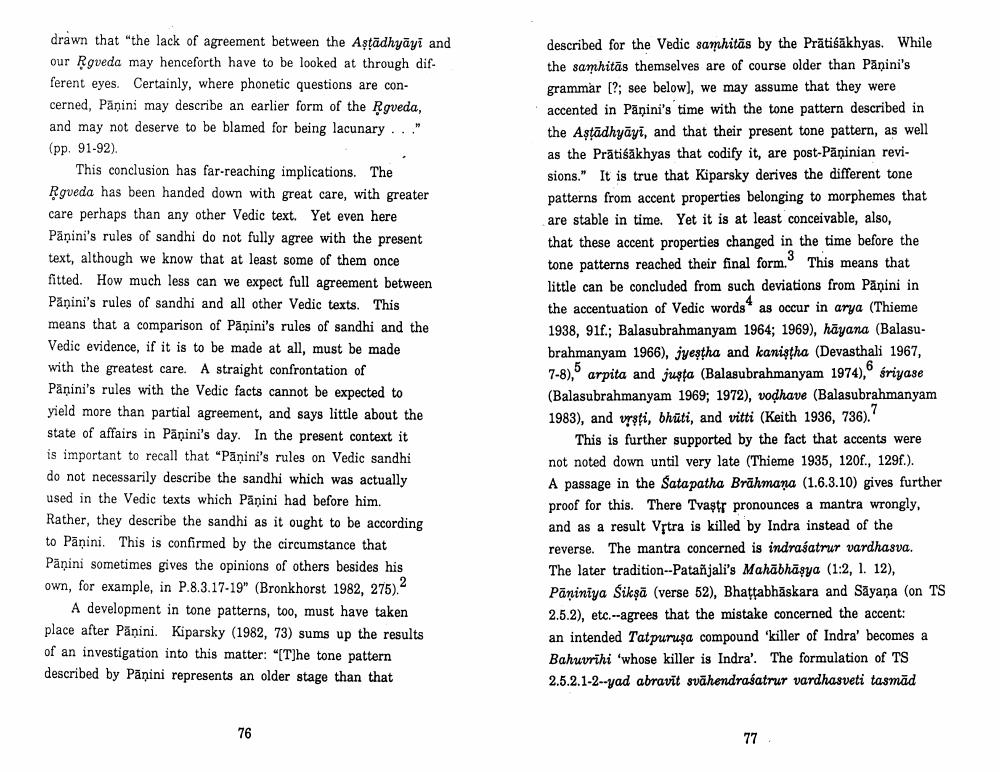Book Title: Paninian And Veda Reconsidered Author(s): Johannes Bronkhorst Publisher: Johannes Bronkhorst View full book textPage 2
________________ drawn that "the lack of agreement between the Aṣṭādhyāyi and our Ṛgveda may henceforth have to be looked at through different eyes. Certainly, where phonetic questions are concerned, Panini may describe an earlier form of the Ṛgveda, and may not deserve to be blamed for being lacunary..." (pp. 91-92). This conclusion has far-reaching implications. The Ṛgueda has been handed down with great care, with greater care perhaps than any other Vedic text. Yet even here Panini's rules of sandhi do not fully agree with the present text, although we know that at least some of them once fitted. How much less can we expect full agreement between Panini's rules of sandhi and all other Vedic texts. This means that a comparison of Panini's rules of sandhi and the Vedic evidence, if it is to be made at all, must be made with the greatest care. A straight confrontation of Panini's rules with the Vedic facts cannot be expected to yield more than partial agreement, and says little about the state of affairs in Panini's day. In the present context it is important to recall that "Panini's rules on Vedic sandhi do not necessarily describe the sandhi which was actually used in the Vedic texts which Panini had before him. Rather, they describe the sandhi as it ought to be according to Panini. This is confirmed by the circumstance that Panini sometimes gives the opinions of others besides his own, for example, in P.8.3.17-19" (Bronkhorst 1982, 275).2 A development in tone patterns, too, must have taken place after Panini. Kiparsky (1982, 73) sums up the results of an investigation into this matter: "[T]he tone pattern described by Panini represents an older stage than that 76 described for the Vedic samhitas by the Prätiśäkhyas. While the samhitäs themselves are of course older than Panini's grammar [?; see below], we may assume that they were accented in Panini's time with the tone pattern described in the Aṣṭādhyayi, and that their present tone pattern, as well as the Prätisśākhyas that codify it, are post-Paninian revisions." It is true that Kiparsky derives the different tone patterns from accent properties belonging to morphemes that are stable in time. Yet it is at least conceivable, also, that these accent properties changed in the time before the tone patterns reached their final form. This means that little can be concluded from such deviations from Panini in the accentuation of Vedic words as occur in arya (Thieme 1938, 91f.; Balasubrahmanyam 1964; 1969), hayana (Balasubrahmanyam 1966), jyestha and kanistha (Devasthali 1967, 7-8), arpita and justa (Balasubrahmanyam 1974), śriyase (Balasubrahmanyam 1969; 1972), voḍhave (Balasubrahmanyam 1983), and vrsti, bhūti, and vitti (Keith 1936, 736)." 3 This is further supported by the fact that accents were not noted down until very late (Thieme 1935, 120f., 129f.). A passage in the Satapatha Brahmana (1.6.3.10) gives further proof for this. There Tvast pronounces a mantra wrongly, and as a result Vrtra is killed by Indra instead of the reverse. The mantra concerned is indrasatrur vardhasva. The later tradition--Patanjali's Mahābhāṣya (1:2, 1. 12), Paniniya Siksä (verse 52), Bhaṭṭabhaskara and Sāyaṇa (on TS 2.5.2), etc.--agrees that the mistake concerned the accent: an intended Tatpuruşa compound 'killer of Indra' becomes a Bahuvrihi 'whose killer is Indra'. The formulation of TS 2.5.2.1-2--yad abravit svahendraśatrur vardhasveti tasmād 77Page Navigation
1 2 3 4 5 6 7 8 9 10 11 12 13 14 15 16 17 18 19 20 21 22 ... 24
